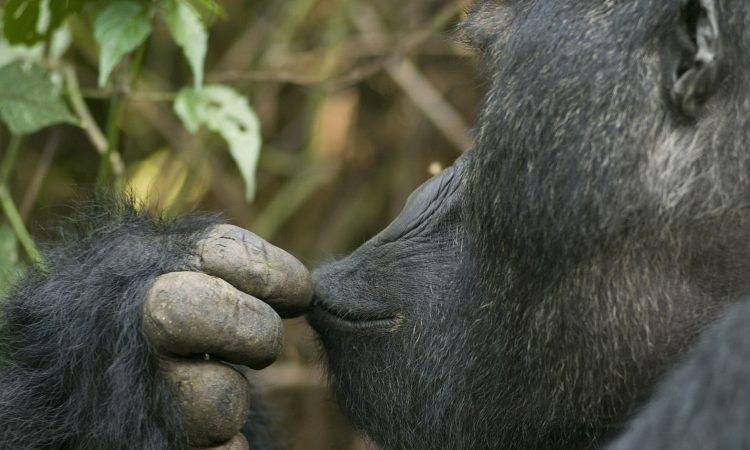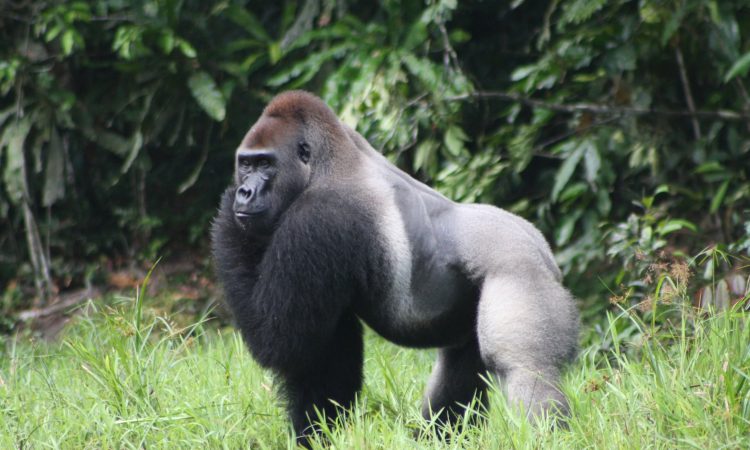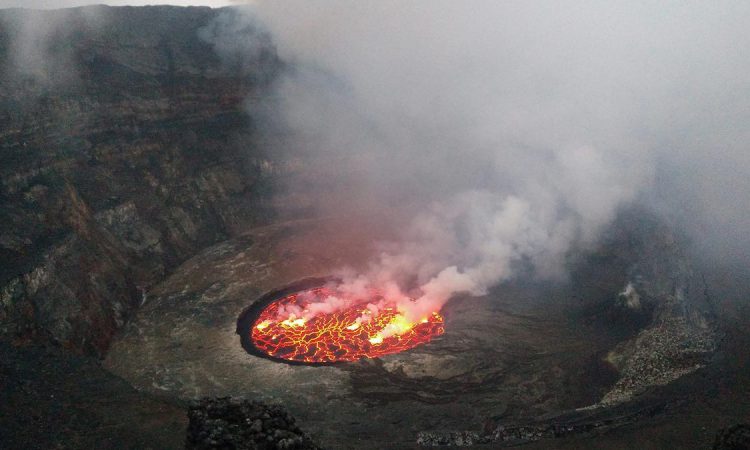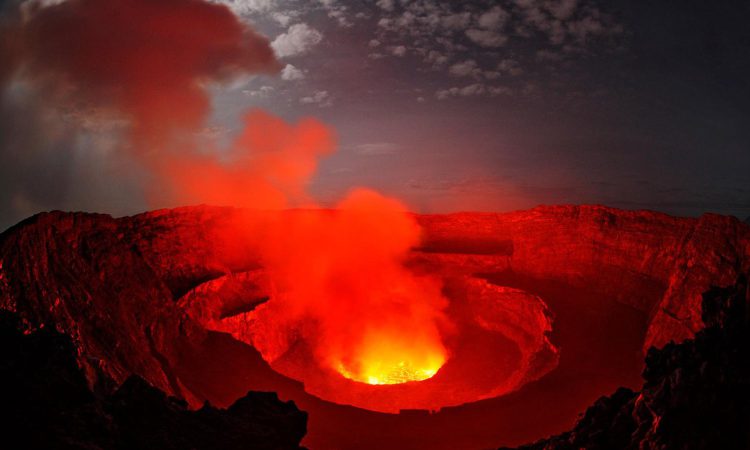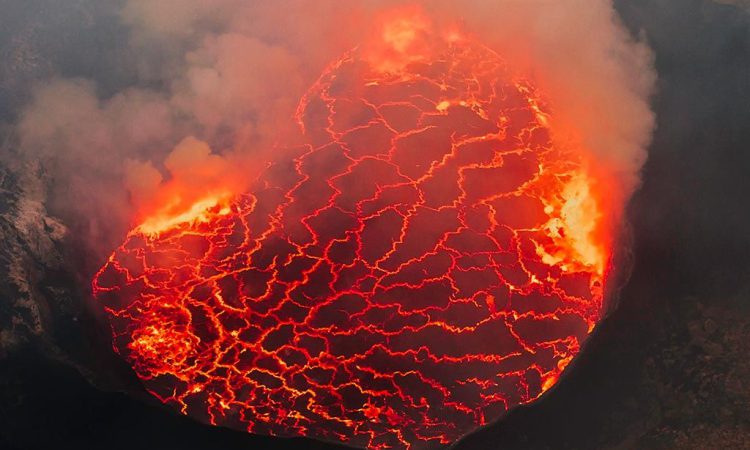Gorilla safaris in Democratic Republic of Congo are primarily conducted in Virunga National Park and Kahuzi-Biega National Park. Apart from those, Democratic Republic of Congo has 5 more national parks, 57 reserves and hunting areas. Other national parks include Garamba, Salonga, Maiko, Kundelungu and Upemba among others. These are home to very significant biodiversity including a variety of endemic and endangered wildlife species.
Mountain Gorilla Trekking in Virunga National Park
Virunga National Park in eastern Democratic Republic of Congo covers a total land area of around 7,769 square kilometers and very popular for mountain gorilla trekking tours. With altitudes varying from 680 to 5,109 meters above sea level, the park is endowed with a diverse range of habitats, like savannahs, forests, lava plains, steppes, wetlands and snowfields etc.
With at least 2,000 plant species, Virunga National Park is comprised of afro-montane forests, tree ferns and lobelia among others. Virunga National Park has about a third of the remaining mountain gorillas in the world. Elephants, hippopotamuses, Thomas kobs, buffaloes are among other resident mammal species besides the endangered mountain gorillas.
Virunga National Park has 13 gorilla groups, eight of them are habituated and can be trekked throughout the year. These groups include Lulengo, Munyanga, Nyakamwe, Mapuwa, Rugendo, Humba, Kabirizi and Bageni. Gorilla trekking tours are basically guided by experienced Virunga rangers or local pisteurs, involving a hike through the dense forest to locate a gorilla group. The trek starts at around 8:00a.m. and takes 2 to 5 hours or more depending on the location of the particular gorilla group or challenges posed by the terrain. Once visitors locate the gorillas, they have only one hour to observe and photograph the primates before returning to the starting point. The minimum age for trekking is 15 and participants must be free of infectious diseases transmissible to gorillas.
Besides gorilla trekking, visitors can enjoy other activities like birdwatching, chimpanzee habituation experiences, nature walks through the forest trails, hiking Nyiragongo volcano, landscape viewing and photographing of the Virungas, Mount Rwenzori and visiting the Senkwekwe Orphanage Center.
Lowland Gorilla Trekking in Kahuzi-Biega National Park
Kahuzi-Biega National Park in the eastern part of the Democratic Republic of Congo spans a total land area of about 6,000 square kilometers and famous for eastern lowland gorilla tracking. The park gets its name from Mountains Kahuzi and Biega at 3,308 meters and 2,790 meters respectively. These are covered with luxurious vegetation that comprise afro-montane forests, bamboo forests and sub-alpine prairies among others. Additionally, Kahuzi-Biega straddles the Albertine Rift region and the Congo Basin thus making it a biodiversity hotspot. Besides the eastern lowland gorillas, Kahuzi-Biega National Park houses a variety of mammals and birds. These include bush buffaloes, bush elephants, bongos, bats and chimpanzees etc.
Kahuzi-Biega National Park is home to a minimum of 9 gorilla groups and at least 2 are habituated for gorilla tracking adventures. Eastern lowland gorilla tracking generally starts as early as 8 a.m. with a briefing session from the park rangers. An experienced ranger guide then guides the trekkers through the gorilla trails as they track a gorilla group in the forest. Meanwhile, trekkers get a chance to spot a variety of other animals and plants, that include red tailed monkeys, olive baboons, blue monkeys and grey-cheeked mangabeys etc.
Trekkers will encounter lowland gorillas and spend only an hour with them. This allows them to watch primates while photographing them in their natural habitat. After this, they will return to the starting point to complete their tour.
The entire trek can take anywhere from 4 to 6 hours, or even longer, depending on the trekker’s physical fitness. Participating in Eastern lowland gorilla trekking tours in Kahuzi-Biega National Park is restricted to individuals aged 15 and older. The hikers can also enjoy various other tour activities in Kahuzi-Biega National Park. These include birding, Lwiro chimpanzee sanctuary visits, hiking the Kahuzi and Biega volcanoes and others.
Mountain Nyiragongo Hiking Tours.
Hiking Mountain Nyiragongo is one of the most unique activities that a tourist can do in combination with a gorilla tracking tour in Virunga National Park. Mount Nyiragongo is an active volcano in the eastern region of the Democratic Republic of Congo and a significant tourist attraction. Mountain Nyiragongo is among the eight volcanoes in the Virunga Massif besides Mount Gahinga, Mount Bisoke, Mount Sabinyo, Mount Muhabura, Mount Karisimbi and Mount Nyamuragira. Mount Nyiragongo, standing at 3,470 meters above sea level overlooks Virunga National Park. Mount Nyiragongo is labelled the deadliest volcano since its an active volcano often releasing lava to flow to the Goma settlements on the foothills.
Mount Nyiragongo offers visitors a medium hike that takes about 5 to 6 hours to reach its summit. This offers visitors the opportunity to view and photograph the remarkable landscapes including the Virunga National Park and other volcanoes. There is also the beautiful Nyiragongo crater lake which is 600 meters deep and visitors can observe it up close. Wildlife species to be spotted include chimps, monkeys, Albertine Rift-endemic three-horned chameleons etc. There are also numerous bird species, comprising the yellow-billed waxbill, double collared sunbird, red-faced cisticola, yellow-fronted canary, spectacled weaver, regal sunbird and others. The time taken for visitors to descend to the slopes is about three hours.
Reaching Mount Nyiragongo is safer through Gisenyi town in Rwanda and into Goma. This is where the starting point of the hike is. Hikers are guided to Kibati village trailhead for a briefing session. Here, they are instructed on the expectations and rules to follow. The hiking adventure is typically split into five different segments, with the lower elevation climbs being the start. The hike becomes gradually challenging with the presence of loose rocks, smooth stones and steeper slopes as you continue to hike. The final segment, though steep compared to the rest, is much shorter and offers views of the summit cabins to motivate hikers to complete their ascension. Hikers should have warm clothing to ensure they survive the cold windy conditions at the summit.
Other safari destinations in D.R. Congo.
Lake Kivu
Kivu is a freshwater lake covering about 2,700 square kilometers and situated at the border of the Democratic Republic of Congo and Rwanda. The proximity of Lake Kivu to the Virunga and Kahuzi-Biega National Parks make it an important tourist destination for visitors to or from gorilla trekking tours. Lake Kivu grants exciting activities like birdwatching, swimming, relaxing, exploring Islands, canoeing, cycling, sport fishing, soccer and visiting the fishing communities among others.
Garamba National Park
This is a 4,920 square kilometers UNESCO World Heritage site situated in the northeast region of Democratic Republic of Congo. Garamba National Park is prestigious for its diverse flora and fauna that occupy the dense forests and vast savannah grasslands and woodlands.
Prominent activities in Garamba National Park include game viewing adventures to watch the lions, elephants, hippos, hyenas and Kordofan giraffes among others; birdwatching to catch sight of the Egyptian goose, plain nightjar and squacco heron among others; guided nature walks to observe different insects, birds, plants, landscapes; boat cruising and sport fishing in the Garamba river among others.
Salonga National Park
This is the largest national park in Central Congo occupying around 36,000 square kilometers. Salonga National Park is also one of the largest tropical forest protected areas in the world with swamps, rivers and other physical features. The park is a significant ecosystem that shelters the endangered bonobo, also known as the pygmy chimpanzee.
Apart from this endemic primate, Salonga National Park is home to a variety of flora and fauna. These include forest elephants, Congo peafowl, blue duikers, giant ground pangolins, African forest buffaloes, Wolf’s Mona monkeys, sitatunga and African grey parrot among others. Salonga National Park grants visitors the opportunities to engage in various tourist activities. These include game viewing, bird watching, guided nature walks, sport fishing in rivers and other exciting activties.
Okapi Wildlife Reserve
This is another UNESCO World Heritage site situated within the Ituri forest in the northeastern part of the Democratic Republic of Congo. Covering an approximate land surface area of 13,700 square kilometers, Okapi Wildlife Reserve is covered with a variety of vegetation. These are dominated by dense evergreen and semi-ever green forests, swamp forests and others. The vegetation is hydrated by waterways and rivers Ituri, Epulu and Nepoko. Okapi Wildlife Reserve is teeming with okapi, forest elephants, chimpanzees, bongo antelope, duikers, genets and African forest buffaloes among others.
The flora include ficus, albizia and celtis among others. Communities adjacent to the reserve include the Mbuti and Efe people. Key tourist activities include tracking the elusive okapis, wildlife viewing, birdwatching, guided nature walks, camping and cultural encounters with the Mbuti pygmies.
Upemba National Park.
Upemba National Park is situated in the southeast of the Democratic Republic of Congo, covering approximately 11,730 square kilometers, making it the second largest in the country. The ecosystem is composed of Afromontane grassland, tropical rainforest, miombo woodland, marshes, Kibara mountains, lakes including Upemba, and various rivers including Lualaba.
Upemba depression consists of archaeological sites that make it a UNESCO World Heritage site. The fauna in the park consists of zebras, racket tailed roller, buffaloes, elephants, shoebills and fire-finch among others. Activities that attract tourists to Upemba National Park include nature walks, hiking the slopes of Mount Kibara, sport fishing, birdwatching, wildlife viewing and cultural encounters with the Luba people to offer visitors the chance of learning about their way of life.
Livingstone Waterfalls
Situated in the western part of the Democratic Republic of Congo, Livingstone Falls are a sequence of huge rapids and waterfalls on Congo River, named after David Livingstone. There are seven falls, including the Grand Inga falls, which is the largest and one of the most powerful in the world.
The water features provide diverse opportunities to enjoy tours in the site. These include kayaking, canoeing, rafting, and other water sports. The site is also bordered by lush forests that offer hiking opportunities for visitors to watch numerous species of birds, insects and plant life among others.
Best Time to Visit Congo.
The optimal time to visit Congo for gorilla trekking tours in either Virunga National Park or Kahuzi-Biega National Parks is during the dry seasons. The dry seasons usually run from June to September as well as from December to February. These periods are marked by sunny and clear days with minimal chances of showers. This ensures drier gorilla trails and less dense vegetation cover, thus facilitating easier trekking. However, some visitors prefer more challenging gorilla trekking adventures. These are experienced during the wet seasons when the vegetation is relatively dense and the gorilla trails muddy and slippery. Such conditions make it more difficult to navigate the trails, at the same time making it harder to locate the gorillas. This makes encountering a gorilla family more fulfilling or rewarding.
Facts about Gorilla Tours in Congo.
- Gorilla trekking safaris in Congo are only conducted by people aged 15 years and above. People below 15 are most likely to ignore instructions or even not understand the significance of conservation.
- Visitors are allowed only one hour in the presence of the gorillas to minimize the chances of them feeling disturbed and anxious.
- Another way of minimizing behavioral disturbance and anxiety is that only eight individuals are allowed to visit a gorilla group in a day.
- Visitors are recommended to maintain at least a 7-meter (or 23 feet) distance from gorillas to minimize the risk of spreading diseases to these
- All participants on gorilla trekking tours should be free of any diseases transmissible to gorillas. It is also advisable to be free of any illness that would affect your ability to trek over long distances.
- While trekking gorillas, ensure that you remain within the group and avoid spreading out or even encircle the gorillas. These strategies ensure the safety of yourself and the gorillas by preventing you from getting lost in the dense forests while causing the primates to not feel threatened.
- Sometimes, a gorilla, silverback in particular might thump their chest or even charge at you. Do not however move or run away, instead you should stay still, do not make eye contact with the gorilla and wait for the ranger guide to instruct you.
- Littering in the jungle is prohibited, so keep all the trash with you until you return to the park offices to dispose of it properly. Also, if you need to use the toilet, consult with the ranger guide to ensure that you do so properly by digging a hole in the ground with a panga and covering it afterward.
- Making noise is prohibited throughout the entire gorilla trek since this might cause disturbance to the gorillas.
- Gorilla trekking tours typically commence at 8 a.m. with a briefing session and only done at day time.
- No flash photography since this might disrupt the gorillas and cause them anxieties, or even charge at you.
- While coughing or sneezing, participants on gorilla trekking tours are advised to turn away to prevent the spread of droplets. Also, they can use the crook of their elbow to cover their mouth and nose when sneezing.
Cost of Congo Gorilla Tours.
To participate in a gorilla trekking adventure in either Virunga National Park or Kahuzi-Biega National Park, you must acquire a gorilla permit at either the park headquarters or a reputable tour company. A permit to trek mountain gorillas in Virunga National Park costs US$450 per person per trek, during peak seasons. While in the low season it is US$200.
To trek Eastern lowland gorillas in Kahuzi-Biega National Park, a visitor needs a permit that costs US$400 if they are foreign non-residents. For East African residents it is US$200 and only US$20 for the Congo citizens.
Congo Weather.
The Democratic Republic of Congo experiences an equatorial type of climate, with varied weather conditions due to regional differences in climate. Annually, the country experiences two rainy seasons and two dry seasons. The rainy seasons run from March to May and from September to November. The dry seasons are experienced from December to February and from June to August.
The monthly average temperature is at least 24.4oC and mean annual precipitation is around 1,500 millimeters. The eastern regions where Virunga and Kahuzi-Biega are situated tend to be cooler and wetter compared to the northern and eastern parts whose weather is largely influenced by the Congo Basin.
Congo Gorilla Trekking Clothing.
A tour in the Democratic Republic of Congo demands that each traveler considers packing and wearing appropriate apparel. That will foster a successfully comfortable tour experience. The clothing to pack includes,
- Comfortable hiking shoes/boots; since gorilla tracking adventures involve walking on rugged and sometimes slippery terrain to locate gorillas. These should be strong and with traction.
- Long sleeved shirts/blouses; since the gorilla tracking adventures happen in tropical forests that house a variety of biting insects in addition to thorny plant species that can rub against your skin.
- Raincoat/jacket; is very essential in the gorilla tracking destinations since they are both tropical rainforests which implies that rainfall is unpredictable, even during the dry seasons.
- Garden gloves; for protecting your hands against germs while trekking since the grounds are often slippery and may cause you to fall, and touch the dirty ground.
- Wide-brimmed hat/cap; to provide shade that helps protect the eyes, face, neck and ears from direct sunlight.
How Long should your Congo Gorilla Tour be?
The number of days required for you to have a successful gorilla tour in Congo depends on quite a number of factors, including the specific national park, travel arrangements and availability of gorilla permits. For example, in Virunga National Park, you will need at least 3 to 6 days to take into consideration your travel to/from the destination, the trekking day, accommodation in or around the park and other tour experiences. The same applies to Eastern lowland gorilla tours in Kahuzi-Biega National Park.


